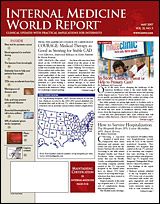Folic Acid May Prevent Periodontal Disease in the Elderly
First-of-Its-Kind Study Links Nutrition and Oral Health
J Am Geriatr Soc
For the first time ever, low serum folate levels have been associated with an increased risk of periodontal disease in older adults in a new population-based, cross-sectional study (. 2007; 55:108-113).
Folate, also known as folic acid, is part of the B-complex vitamin and is best known for its role in the prevention of neural tube defects in the fetus. Vitamin B, including folate, deficiency is common in the elderly.
Evidence indicates that folic acid can protect against several age-related diseases, but this is the first study to examine the relationship between serum folic acid and periodontal disease in older adults. Investigators looked at 844 participants (aged ≥60 years; 60% white) from the 2001-2002 National Health and Nutrition Examination Survey (NHANES) who had undergone periodontal examinations and for whom serum folate levels (median level, 15.9 ng/mL) were available.
All participants had a periodontal examination at 3 sites of up to 14 teeth. Periodontal disease was identified in 14.8% of the participants.
Patients were divided into quartiles based on baseline serum folate levels. Low levels of folate were correlated with the presence of periodontal disease (Table). The relationship between folate levels and periodontal disease remained statistically significant after controlling for all potentially confounding factors.
Investigators concluded that for each SD increase in natural-log-transformed serum folate levels, the likelihood of periodontal disease decreased by about 27%. Serum folate levels were also positively correlated with vitamin B12 levels and negatively correlated with homocysteine levels.
This first-of-its-kind study “provides information about the potential role of folic acid in the prevention of periodontal disease and underscores the importance of nutritional status for oral health,” the investigators, led by Yau- Hua Yu, DDS, DMSc, write. They add that the results are not yet generalizable to the entire US population, because the study population was limited to NHANES participants who had undergone a periodontal exam and for whom serum folate level data were available.
Serum folic acid levels can be increased simply by eating foods that contain high concentrations of folate, including asparagus, liver, lentils, pinto beans, black beans, and spinach.
However, even when the body is operating at full efficiency, which is not always the case in the elderly, only about 50% of folate from food sources can be absorbed, according to the George Mateljan Foundation (a nonprofit organization that provides information about healthy foods).
